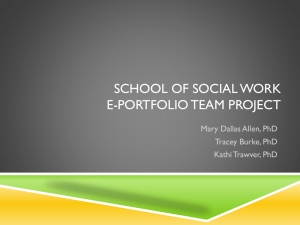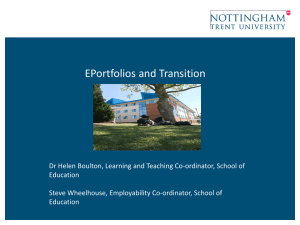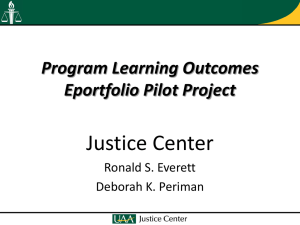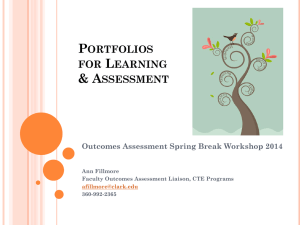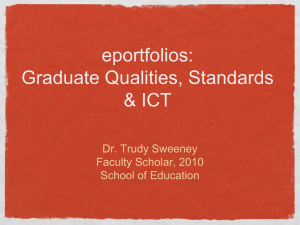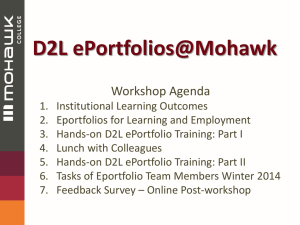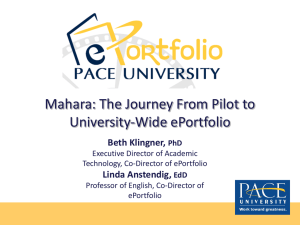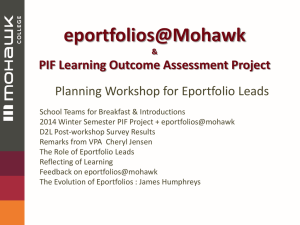Final Report ePTG
advertisement
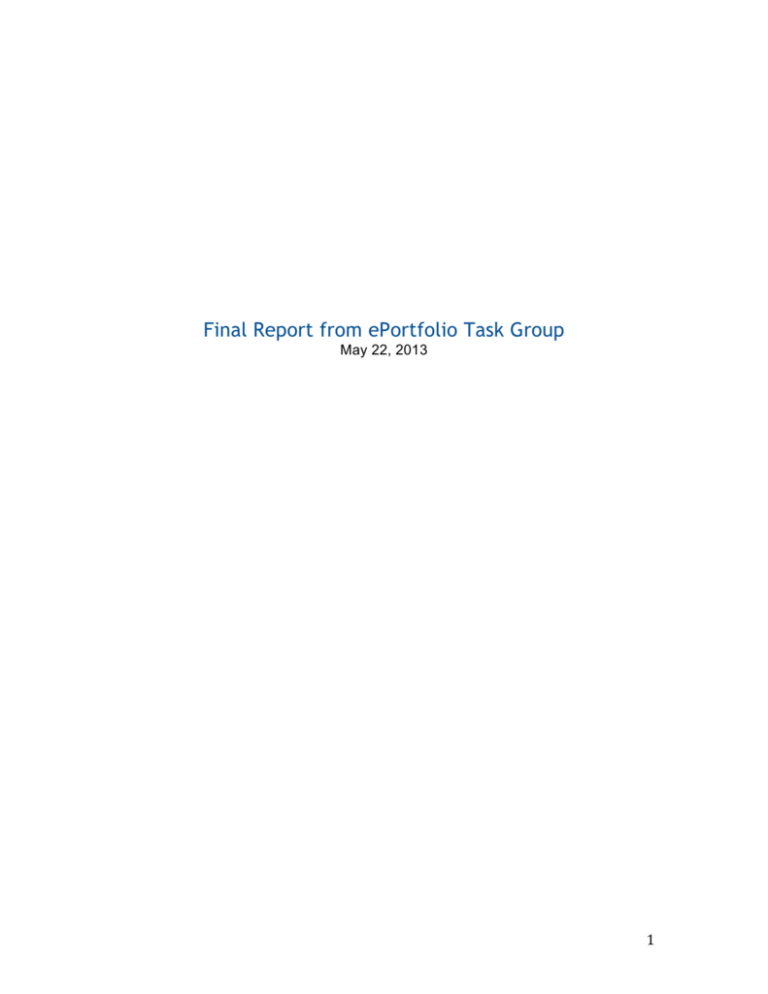
Final Report from ePortfolio Task Group May 22, 2013 1 Final Report from ePortfolio Task Group May 22, 2013 Members: Ellen Marie Murphy, Chair Chris Widdall, SUNY Cortland Nancy Wozniak, StonyBrook Keith Landa, SUNY Purchase Greg Conyers, Downstate Medical Catherine Roche, Rockland Community College Deborah Klesenski-Rispoli, Fashion Institute of Technology Nan Travers, Empire State College Edwin Tjoe, StonyBrook Joggeshwar (Jogy) Das, SUNY Oswego Eric Machan Howd, Cornell Gary Halada, StonyBrook Linda Frank, Empire State College Introduction The ePortfolio Task Group began its work on August 30th, 2012. We were charged with focusing on the strategy and potential implementation of e-portfolios across the System, independent of any particular product or platform. The Task Group will investigate current and projected uses of ePortfolios within SUNY, as well as in K-12 and training and employment. In addition, we will study uses of ePortfolios in other other states, as well as those being implemented on national or international levels. The Group was particularly concerned with how ePortfolios could be an integral part of Open SUNY and sought to answer a number of questions including: 1. How can ePortfolios support Open SUNY? 2. How can the effective use of ePortfolios in teaching training programs impact their use in K-12 education? 3. How can ePortfolios support the recognition of prior learning (SUNY REAL)? 4. How can ePortfolios be used to support self-directed and lifelong learning? 5. How can we encourage a broad adoption and how do we provide support? 6. What are the components of a successful implementation? 7. How can ePortfolios be used for assessment? 8. How can ePortfolios be used to develop self-reflection, self-efficacy? 9. How can ePortfolios be used in the Admission process? Define ePortfolio and purposes 1. What is an ePortfolio? Unlike most of the enterprise systems deployed by educational institutions which are institutionally focused and owned, the ePortfolio is user centric. While eportfolios can 2 be used as source of information to support institutional assessment efforts, ePortfolios should not be thought of primarily as an institutional data collection system. It should be noted: in an article entitled ePortfolios: Go Big or Go Home the author, researcher Darren Cambridge states “It is an oversimplification to say that eportfolios cannot be used simultaneously for learning and assessment, but such use requires the integration of e-portfolio activities across the curriculum at a scale almost never attempted by programs invested only in meeting the demands of external accountability.” http://www.educause.edu/ero/article/e-portfolios-go-big-orgo-home. This may explain why ePortfolio implementations generally are not as successful as planned. This Task Group defines an ePortfolio as: a digital tool that creates an active, personal venue for demonstrating self-directed lifelong learning including evidence of the acquisition of skills and knowledge, individual accomplishments, service, and personal growth. In an American Society for Engineering Education article, Using Electronic Portfolios in a Large Engineering Program, the authors offer a simple, concise definition. Notice how the portfolio process grows an "e". A portfolio is a purposeful collection of artifacts to demonstrate effort, progress and achievement. Within an educational setting a portfolio can be prepared in the context of a course, a program, or an institution; the author of the portfolio can be the student, a faculty member, an administrator, or an organization (depart, program, etc.); and the purpose of the portfolio may be developmental, evaluative, and/or representative. With the ever increasing use and advancement of technology, the electronic portfolio (ePortfolio) is emerging as a viable option to the traditional paper portfolio. (Knott, Wolfe, Muffo, Mallikarjunan, Loganathan, Lohani, Paretti, Griffin, Adel , 2005) 2. How are ePortfolios being used: • EPAC (ePortfolio California) states there are three kinds of ePortfolios: o Developmental (e.g., working) - a record of artifacts (work and accomplishments) that the owner has done over a period of time, and may be directly tied to learner outcomes or rubrics. o Reflective (e.g., learning) - includes personal reflection on the content and what it means for the owner's development. o Representational (e.g., showcase, professional, and teaching) provides evidence of the owner's achievements in relation to particular work or developmental goals and is, therefore, selective. When it is used for job purposes (searches and promotions) it is sometimes called a Career portfolio. http://eportfolioca.org/index.php?option=com_content&view=article&id=58 • ePortfolios are being used to help students make their own learning connections between their coursework, professional career goals, co- 3 curricular activities, campus involvement, community service, job experiences, and personal interests. • ePortfolios have the ability to enhance teaching, learning, and assessment practices. They can also support o student advising and career development o student or alumni credential documentation o sharing of teaching philosophies and practices o department and program self-studies o institutional and program accreditation processes - George Lorenzo and John Ittleson, An Overview of ePortfolios, Educause Learning Initiative, July 2005, retrieved from http://net.educause.edu/ir/library/pdf/ELI3001.pdf • ePortfolios can provide a more “expansive collection of data” than typical methods of assessment. When archived, ePortfolios can be “analyzed to shed light on the meaning of patterns of performance” (Cambridge, 2010) ePortfolios provide an authentic assessment of learning as they are evidence based ePortfolios are used across the United States for credentialing: in teacher certification programs, and medical education to name a few. ePortfolios are being used to support and assess experiential learning • • • Current state of ePortfolios at SUNY 1. Where and how are they currently being used (summary of data from survey(s)) The At SUNY subgroup developed an online survey to collect information about ePortfolio use across the system. (Survey available at: http://goo.gl/0veNp) Survey requests were sent out to all SUNY campuses, through the list of FACT2 representatives, to directors of teaching & learning centers, through CPD lists, and through personal contacts of committee members. One or more responses were received from 42 campuses (70% of community colleges; 71% of technical colleges; 62% of comprehensive colleges; and 78% of university centers & medical schools) Of the responding campuses, 61% reported some use of ePortfolios on their campus (community colleges - 55%; technical colleges - 60%; comprehensive colleges 89%; university centers/medical - 43%). It’s possible that these numbers represent lower bounds, as there may be ePortfolio activity on campus that the survey responders are not aware of. In no case was the ePortfolio use campus-wide though. The most commonly listed use of ePortfolios across SUNY campuses was as assignments in individual courses (22 responses). Along these lines, the use of ePortfolios to support student learning and other high-impact activities was reported for: student-owned learning showcase (14); capstone experience (12); internships (8); first year experience (7); independent personal reflection (5); group projects (5); and service learning (4). Taken together, it is clear that much of the use of ePortfolios across SUNY campuses is focused on supporting student learning, 4 especially opportunities for integrative and reflective learning. Student ePortfolios also contributed to broader institutional needs in terms of: program assessment (13); professional accreditation (6) and institutional assessment (3). In development is an intercampus ePortfolio project between SUNY Delhi and SUNY Purchase, with the potential of including other schools as well. 2. How are they being used in the Admissions process? a. Portfolios are accepted and reviewed by Cortland’s admissions officers, and while they are prepared to accept and review ePortfolios they have not received them. IBS schools have an extensive standards-based and portfolio process, but these are submitted as printed versions of edocuments. b. SUNY Purchase requires an eportfolio submission for admission into several of their art programs. They use a third party provider called SlideRoom for portfolio submissions. Students upload their artifacts to Purchase’s site on SlideRoom. The Fashion Institute uses a similar process. 3. How are they being used for Assessment of Prior Learning? Prior learning assessment has traditionally used a portfolio process for students to document and demonstrate their learning and as a vehicle to assess that learning for college credit. SUNY Empire State College has been part of the national FIPSE grant, Connect to Learn, managed by CUNY LaGuardia Community College. Within this grant, Empire State College has had three projects using ePortfolios to assist students through the prior learning assessment process as they engage in degree planning. Empire State College is a participant in the TAA Grant, within which eportfolios will be used for prior learning assessment. In addition, through the Lumina grant given to the Open SUNY/ SUNY REAL project, ePortfolios will play a major role in the ways in which students prior and open learning is assessed. 4. How are they being used for Career Development? It does not appear that SUNY is currently using ePortfolios for Career Development. ePortfolios are being used globally for career preparation, and are becoming recognized widely by employers. Career Centers collaborating with faculty, instructional support staff, advising staff, and industry professionals to guide the students with the interview process and the creation of their career eportfolios, will be important for SUNY going forward. 5. How are they being used in Teacher Preparation? SUNY Cortland as is many other colleges use of portfolios was seen as a means to demonstrate prospective student’s knowledge base on curriculum and standards within their disciplines. In some universities students were encourage to develop the portfolio as a demonstration of excellence for use in potential employment. Portfolios were used to allow students to select their best artifacts within specific areas, such as standards within their given field or benchmark areas within a teacher work sample. Students were asked to re-evaluate their selections throughout their preparation program and then continue to add, change, or reflect on their learning. 5 Several programs were using some type of portfolio process as their NCATE or program assessment tool. Use of ePortfolios in NY State 1. Career Zone http://careerzone.ny.gov provides a space where students (6-12) and out-of-school youth build career portfolios. Sponsored by the NY State Department of Labor— 2. Job Zone https://jobzone.ny.gov/views/jobzone/guest.jsf sponsored by the New York State Department of Labor. Not a true ePortfolio, however These portfolios provide private workspace for: o Assessment tools for determining occupations and job skill gap analysis. This is run against the training provider list. o Resume building for all types of experiences o Job search o Occupations are matched to CIP codes and equivalent majors at postsecondary education institutions • Note: the NY State Department of Labor is interested in working with SUNY in the development of more comprehensive ePortfolios and integrating the two systems (see Appendix) 3. The use of student learning eportfolios in K-12 is not currently required in NY State, though nationally interest in the use of ePortfolios is growing, particularly as a result of Common Core Standards requirements. A few states now require ePortfolios for their K-12 students . Many school districts, however, do not have the funding to provide ePortfolios for their students, nor the training to know how to incorporate them into the classroom. School districts often use free sites like Google sites http://www.nassaubocesperkins.org/eportfolios.htm, and some are using Open Source options like Mahara. There are several Mahara sites that offer ePortfolios for free including: http://foliofor.me/ and http://www.portfoliocommunities.com/. There is currently no wide spread use within NY State K-12 districts. Here are examples of K-12 eportfolios use on the Digication K-12 site http://www.digication.com/featured/k12. Other examples can be found at Introduction to K-12 ePortfolios at https://sites.google.com/site/k12eportfolios/resources/examples-of-online-portfolios. Regional K-12 professional development groups for eportfolio use are being promoted and formed. An example is the active Staten Island-South Brooklyn Professional Development Group. Their website can be viewed at https://titleiidgrants.wikispaces.com/Foundations+of+ePortfolios+in+K-12+Education . It is recommended that SUNY sponsor and support regional K-12 professional development groups. 6 What are the opportunities for ePortfolios at SUNY? 1. Professional Use and Accreditation Many professional accreditation organizations are recognizing the use of eportfolios to document required skills and competencies necessary for industry standard performance. The eportfolio process, which includes inquiry and evidence-based reflective practices, provides authentic evidence of students meeting the required competencies, including those that are difficult to measure, such as compassion, ethics, and an understanding of lifelong learning. The Colleges of Medical/Health Services and Engineering are examples of successful eportfolio use in the SUNY system. Medical schools and Health Services Programs Health care Professionals are called upon to demonstrate competence in many areas and through a multitude of assessments. Skills and abilities are demonstrated not just through performance tests but also through an array of other dimensions such as scholarly publications, patient encounters, and clinical skills demonstrations. In the health professions, students demonstrate competence through a broad array of assessment evidence and ePortfolios are becoming widely accepted as a tool particularly well suited to organize disparate evidence to form a composite picture of performance (Dannefer 2012; Tartwijk 2009).. An ePortfolio not only provides evidence of accomplishments, but also enables the individual to record reflections about the evidence thereby supporting the growth and development of the “reflective practitioner” (Schon 1984). Furthermore, faculty may also benefit from having a defined template to record accomplishments beyond information in curriculum vitae such as in teaching. The American Association of Medical Colleges (AAMC) and the National Board of Medical Examiners (NBME) are preparing to launch eFolio Connector--an ePortfolio platform to be used by physicians and medical students: https://members.aamc.org/eweb/upload/110212_GGC_1000_Bostrom_Dana.pdf This system, as mentioned above, will use the LEAP2A standard. Nursing schools are also looking to adopt the use of ePortfolios for the assessment of competencies as well. Engineering The following ABET (Accreditation Board for Engineering and Technology) assessment criteria are similar to those of accrediting institutions for education and the healthcare field, and are best met through the use of an ePortfolio: • • • ABET Criteria 2: Program Educational Objectives ABET Criteria 3: Student Outcomes ABET Criteria 4: Continuous Improvement http://www.abet.org/assessment-planning/ 7 Additionally, lifelong learning is a listed accreditation criteria for demonstrated student outcomes. Education Beginning on May 1, 2014, initial teacher certification for New York State will require passing an ePortfolio assessment (edTPA) http://edtpa.aacte.org/ http://www.nystce.nesinc.com/NY_annTPA.asp 2. How can inquiry, evidenced-based reflective, and integrative learning be promoted across the system? There must be a change in educational teaching practice. Integrative learning practices must be considered the normal. Instructors should be encouraged to create a learning environment where students engage with each other and learn from their peers in a reflective and collaborative way. If we as a system want to generate a state program that encourages inquiry and evidenced-based, reflective learning we need to insure student-centered learning practices are continually used and authentic experiential, evidencebased assessment becomes the norm. Faculty should be recognized for using these teaching practices. In their article, A New Paradigm for Undergraduate Education, Robert Barr and John Tagg illustrated A shift in the Paradigm of Education from the teacher-centered Instruction Paradigm to the student-centered Learning Paradigm. The Instruction Paradigm is concerned with teaching productivity while the Learning Paradigm centers on learning productivity. The main focus for the Learning Paradigm is to involve students in the teaching and learning process and produce learning outcomes more efficiently. With the shift, the controlled, competitive, individualistic instruction classroom becomes a collaborative, cooperative, supportive learning environment that fosters inquiry, reflection and higher order cognitive skills. In this rich learning environment, the integrative eportfolio process emerges as a method to produce, document and connect the learning. It is clear how the integrative eportfolio learning process (Collect, Select, Reflect, Connect and Project) enriches the mission and purposes of the Learning Paradigm (Barr & Tagg, 1995) to • • • • • produce learning, elicit students discovery and construction of knowledge, create powerful learning environments, improve the quality of learning, and achieve success for a diverse population of students. (Wozniak 2013) 8 Recommendation - Coordinated through the SUNY Center for Professional Development, hold frequent regional faculty and student showcases that demonstrate the implementation of the Learning Paradigm through the use of eportfolios. Recommendation - Professional Development and a formation of an ePortfolio Community of Interest -Professional Development series, regional seminars, and workshops should be coordinated through the Center for Professional Development. The use of eportfolios to promote inquiry and evidencebased reflective skills and abilities might be a part of an Instructional Design Certificate - Part II. -Develop an interactive resource and exchange site (SUNY Learning Commons) to showcase assignments and projects that enhance inquiry, evidence-based learning and demonstrate the students making integrative learning connections between curricular and cocurricular activities. -Involve the students. Sponsor project and eportfolio showcases (regional and at CIT) Create an interactive, online directory that features model eportfolios demonstrating inquiry, evidence-based reflection, and integrative learning connections. 3. Evidence of Integrative Learning skills and abilities Integrative Learning ePortfolios are used to facilitate the integrative learning process as students connect and make meaning of the knowledge and skills gained from their life experiences. The ePortfolio process (collect, select, reflect, connect, and project) allows students to collect, select, reflect, connect, and project their learning experiences and collaboratively exchange learning activities and experiences across SUNY. There needs to be a serious attempt to see how we can work together as a system and not jeopardize our students with lack of completion because credits do not transfer and content in some areas is not collectively considered acceptable. Demonstration of the knowledge is always more important than a letter grade. Recommendation - Form regional and SUNY-wide faculty and student cohorts around high impact programs and learning situations such as - First Year Experience - Undergraduate Experience (Gen. Ed ) - Capstone Experiences - Internships 9 - Service Learning - Common Intellectual Experiences - Core Curriculum - Learning Communities - Writing Intensive Courses - Experiential Collaborative Assignments and Projects - Diversity/Global Learning See AACU High Impact Learning Practices http://www.aacu.org/leap/documents/hip_tables.pdf 4. connector to K12 systems, incorporation into admissions, have our ed majors trained to incorporate ePortfolios into K12 instruction. This should be done with partnership schools throughout the state. 5. promote and facilitate transitions from K12 to college to career through administrative involvement, the formation of regional professional development groups and communities of interest. It Takes a Village concept - This would be a collaborative effort between SUNY and K-12 Administration, K-12 and Higher Education Faculty, Advising Staff, Higher Education Admissions, students, Library Services, Career Services, Instructional and Technology Designers, Alumni Services, Representatives from Professional Services, Business, and Industry. 6. SUNY-supported lifelong learning system K-20+: school districts do not have the funds to purchase, nor the technical staff, to support school district owned ePortfolios. Both SUNY and K-12 education in NY would benefit from SUNY providing hosting services to K-12 schools—or if schools are encouraged to use services, they would benefit from the expertise of professional within SUNY. This would also have a positive impact on teacher preparation and recertification programs. 7. professional development credits 8. teacher preparation programs 9. high impact undergraduate programs integrative learning *During our conversations with education leaders in the K-12 sector, several of the leaders noted that use of a portfolio process that could travel with educators to streamline continuing education credits, movement through performance assessment processes, teacher certifications, etc...would be extremely helpful. A system-wide platform 1. What are the benefits? 10 • • • • • • • Students would be able to have one ePortfolio in which to store and display their work, while attending classes at numerous institutions within the SUNY system. Students transferring between institutions will have a continuous record of their work. There would be no need to transfer artifacts or portfolios between systems. Training and support would be more consistent and should be more cost effective than if multiple systems are in place. System wide analytics would be much easier to accomplish if all of the portfolios were housed in one location in a shared database. Migration to a new architecture would be easier in the future should a new system be desirable. Standards are easier to enforce and integration points such as institutional artifact uploading would be easier to develop. 2. What are the drawbacks? • If the chosen platform does not meet all of the needs of the individual campuses and/or programs within the system, adoption will fail. • If the platform was hosted as one system, it could inhibit creativity due to the need to maintain one common version. A school who wishes to adopt a new plugin or create a new add on for the portfolio may not be able to implement it. Modifications may be left to a voting mechanism in which a majority of schools must request a modification in order for it to be authorized, and an inventive school could be restricted from modifications. 3. What might impede the ability to create a system-wide platform? • Several of the SUNY programs are committed to the use of a particular platform, which may or may not use a standard format that would allow for interoperability. • Varying needs of specific programs, for example: Education and Health Science. • Emphasis placed on one aspect of an ePortfolio, which is in opposition to another emphasis. • Institutions insisting on autonomy in choosing a platform. 4. Is there a way to allow for individual options while maintaining a systemwide use of ePortfolios? Because interoperability is important to the successful use of ePortfolios in Open SUNY, SUNY will either need to insist that the institutions use a common system, or that institutions will need to choose eportfolio platforms that share common interoperability standards. (ex: LEAP2A, IMS, xml). Additionally, SUNY will need to determine if it is necessary for the ePortfolio system to integrate with the edTPA program for teacher certification, with other ePortfolio programs such as Efolio Connection (medical schools), with systems at the Department of Labor, and if it is important to integrate the system with the institutional LMS. 5. What supports need to be in place for a successful system-wide adoption? 11 A central support structure would be needed to have system wide adoption. SUNY has several examples of this type of structure that could serve as a model or be leveraged (e.g. SICAS/ITEC, SLN , CPD) A leader/visionary/group to encourage and manage the system-wide adoption of ePortfolios. This individual (or group) would: • provide a vision for the adoption • visit campuses to discuss the system-wide adoption of ePortfolios and meet with key academic and technical implementers (be approachable) • work with faculty to develop a common set of rubrics • work with the NY State Dept of Labor and business leaders to develop common terminology and a SUNY-wide rubric, based on employer input for developing career eportfolios • work with SUNY CPD to develop workshops • build a community of practice and insure ongoing communication • work with K-12 leaders and the NY State Dept of Education in building ePortfolios into o teacher certification and recertification programs o the admissions process, o curriculum that includes teaching and learning using ePortfolios o encourage the creation of a NY State Educators ePortfolio • work with Academic Affairs officers to encourage the adoption of ePortfolios for Promotion & Tenure • encourage the development of programs and events that bring SUNY’s ePortfolio research and practices into State, National and International spotlights • work with Student Services on the various campuses to implement support for students • work with Advisors and Admissions officers 6. What would be the timeline for such an implementation? Because numerous campuses within SUNY are already either using an ePortfolio, in the beginning phases of implementing an ePortfolio, or are in the process of choosing an ePortfolio, it is important that SUNY acts quickly on this. An RFI should be issued and SUNY campuses should be informed that a decision with regards to a system-wide platform will be forthcoming--so that campuses that have not yet officially adopted an ePortfolio will not do so in the interim. A process, similar to the process edTPA is using to integrate ePortfolio platforms into their system, should be developed in order to work with schools that are already heavily invested in a particular platform. Recommendations 1. What are the specific technical requirements of an ePortfolio platform? a. Interoperable with other ePortfolios--this is perhaps the most important aspect of a SUNY system. It is important that ePortfolios in the SUNY network adhere to ePortfolio standard file formats--interoperability/portability would enable the migration of eportfolios as integral wholes between institutions/platforms. Currently there are two primary standards: IMS Global and LEAP2A. The LEAP2A specifications are currently being used by a 12 number of ePortfolio platforms including: Mahara and Pebblepad http://www.leapspecs.org/2A/who-is-using-leap2a; additionally Medbiquitous (which develops standards for applications used by medical schools) is developing an ePortfolio system which will use LEAP2A specifications (eFolio Connector): http://www.medbiq.org/std_specs/standards/index.html, http://blogs.ubc.ca/ranvir/files/2012/10/Assignment1_RB.pdf A list of of IMS compliant products can be found here: http://developers.imsglobal.org/catalog.html The ePortfolio systems on this list are Mahara, Pebblepad, Chalk and Wire, Pathbright and TaskStream. Note: While a common LMS allows us to transfer course materials between systems, and collect data on cohorts of students, they do not allow for the export or transport of a collection of artifacts belonging to an individual. While an LMS may show changes in a program over time, they are not built to show a specific individual’s growth over time. The LMS is institutionally focused, while the ePortfolio is user focused. Without interoperability and/or using a standard format, the ePortfolio can not become a lifelong learning ePortfolio, nor will it serve the needs of Open SUNY. • It should be noted here that the New York State Department of Education requires candidates for certification to submit their materials for scoring (artifact and reflections that show how each standard is met) to the edTPA program--a platform developed by Stanford University and Pearson. While students can upload their work directly to the edTPA system, several ePortfolio programs have met edTPA’s requirements allowing them to integrate with this system (although not necessarily abiding by common interoperability standards). What this “integration” means is that students can submit their materials to the edTPA program directly from their ePortfolio. The ePortfolio programs that currently integrate with edTPA are: o Chalk & Wire o Data180 o Foliotek o ILAT o LiveText o Nuventive o TaskStream o Tk20 o Digication (Fall 2013)* *edTPA continues to work with Platform Providers to meet the technical requirements and agreements that will allow them integration with the system. A recent email communication from edTPA states that “The Platform Providers that have been selected for Fall 2013 edTPA Platform Provider integration have been notified.We will be reviewing requirements and agreements with them over the next few weeks. After they confirm that they will be able to develop components 13 to meet the requirements and the agreements have been signed, we will be able to disclose which Platform Providers have committed to completing the integration. At that time, Platform Providers may have a better idea of the timeline for development and deployment of the integration.” (Georgiann, edTPA IHE Support Team, personal communication, 05/14/2013) More information on edTPA can be found here: http://edtpa.aacte.org/faq#18 Summary: Mahara is both IMS Global and LEAP2A compatible, but is not currently integrated with edTPA. Mahara is an opensource application. Chalk & Wire and TaskStream use IMS Global Standards and are able to be integrated with edTPA, but neither uses LEAP2A. Both of the latter platforms are proprietary. The other platforms use neither IMS Global, nor LEAP2A standards, though they may be integrated with edTPA. As mentioned above, edTPA will work with platforms to insure integration with their system. It should be noted that medical schools will be using a platform that uses LEAP2A • Large system-wide implementations of ePortfolio is not new. Examples include eFolio Minnesota, EPAC (ePortfolio California), MyPortfolio (a national ePortfolio in New Zealand), the Australian ePortfolio Project, and the PADSHE project in England (which lead to the development of the Centre for International ePortfolio Development) to name a few. What these projects have discovered is that in order for such projects to be successful, it is important that the connections between institutions of higher education, K-12, and employers need to be built into the program and that these connections need to include “similar technical and conceptual coordination” (Cambridge, 2010) http://www.nottingham.ac.uk/CIePD/index.aspx , http://www.minedu.govt.nz/~/media/MinEdu/Files/EducationSectors/PrimaryS econdary/Initiatives/ITAdminSystems/DigitalPortfoliosGuidelinesforbeginners. pdf alternative: Multi-institutional (support separate institutions on one instance)--if SUNY chooses to implement a single platform, this would allow for instructors and students across SUNY to share ePortfolios and best practices more easily, while allowing each institution to remain it’s own entity. It would also insure portability. A multi-institutional system could also provide a way for SUNY to support K-12 institutional ePortfolios. An example of a successful implementation of this, is the work done by the Ministry of Education in New Zealand--a project called MyPortfolio. b. flexible and able to meet the differing needs of divisions within the departments and campuses. Long term research on ePortfolios done across the U.K. by JISC (Joint Information Systems Committee) and research done by ECAR (Educause Center for Applied Research) have stated that a key component to the successful implementation of an ePortfolio platform is “one ePortfolio system that works in all situations” or that suits all the needs 14 of the various constituents. In other words: platform matters! (Reese & Levy 2009; Joyes, Gary & Hartnell-Young, 2010) c. Integrates seamlessly with an LMS (or is built into an LMS)--allows for seamless transfer of artifacts. Again the ECAR report states: “insufficient integration with other information technology systems may inhibit e-portfolio use. A community will find it easier to work with e-portfolios if the application integrates with other systems (e.g., course management systems, student information systems) and allows students and faculty to easily transfer content between applications.“ (Reese & Levy 2009) d. Supports lifelong learning--use after graduation e. Supports visual customization by the various institutions (branding) f. Portfolios can be archived and/or exported in standard formats for permanent records 2. What are the specific functional requirements of an ePortfolio system? a. User centric b. Repository managed by the user: Artifacts may be discrete or packaged c. Allows for multiple file formats including video, audio, images and text d. Can display embedded media from within the system as well as external media e. Provides the ability to create multiple blogs, and other methods for recording reflections f. Includes a resume builder g. Allows user to create multiple portfolios (pages, views, etc) for different purposes h. Access levels can be set independently for every portfolio page i. Individuals can repurpose artifacts--appropriate them into various purposes for various audiences. j. Allows for the creation of templates k. Provides for user customization/personalization l. Will support the collection and display of Continuing Professional Development activities and hours m. Will support badging n. Will display external content including RSS feeds, and Google Drive documents 15 o. Provides methods for peer-reviewed and instructor comments and feedback p. Provides support for displaying a variety of goals including academic, career and personal. q. Supports a way of recording and reflecting on co-curricular activities including internships r. Support the needs of all SUNY programs that require an ePortfolio (able to be used in any context and for any program) s. Provides for the display of awards and certificates t. Institution should be able to push out certified artifacts into the student’s repository t. Flexible and has ease of use u. Plugins or other customization features that would allow for things like Facebook likes, embedding twitter feeds, Linkedin, etc. 3. What are the best methods for developing a system-wide environment that supports and encourages the use of ePortfolios? a. Faculty should be encouraged to use ePortfolios for their personal and professional growth as well as for Promotion & Tenure b. ePortfolios should be accepted and used in the admissions process c. The system chosen should work for all programs including Fine Arts, Education, Engineering, Health Services, Medical Education, Business (platform does matter) d. The use of ePortfolios should be built into the curriculum: first year experience, general education, etc. e. Advisors should be encouraged to help students build a career portfolio f. Teach education students how to use them in their K-12 classrooms— require lesson plans that include the use of ePortfolios g. Develop a culture that fosters reflective practice h. Develop an environment that supports the use of ePortfolios across the curriculum i. Encourage students to take ownership of their ePortfolio and their learning. j. ePortfolios should be available to students after they graduate k. all students should be encouraged to develop a career portfolio l. ePortfolios should be used in the PLA (SUNY REAL) process 16 4. What training will be necessary to insure best practices? a. Include in Freshman seminars b. Provide ongoing workshops and other professional development opportunities for faculty and staff c. Form a community of practice around ePortfolios d. Build a social networking component into a system portfolio that will allow faculty to share ideas and information with each other, and allow students across SUNY to share with each other as well. e. Develop a repository of rubrics and best practices. 5. How can the system encourage research in the field of ePortfolios? • See the process of ePortfolios as scholarly content and a publishing process. • Provide grants that encourage research on ePortfolios • include ePortfolios in the promotion and tenure process 6. What systems will be in place to support student use of an ePortfolio? • Student Support Services across the SUNY System should be encouraged to develop means for encouraging student use of an ePortfolio, for providing student workshops on the importance and benefits of ePortfolios, and provide support services in the development of ePortfolios. • Students seeking assessment of prior learning should be encouraged to use an ePortfolio • create a SUNY environment that supports the use of ePortfolios • faculty use of ePortfolios for their own professional purposes will model good practices for students. • student ownership of the ePortfolio is critical • incorporate the use of ePortfolios into the curriculum 7. What structures will the system put in place to support the use of ePortfolios for career development and lifelong learning? a. PLA processes need to be incorporated into the ePortfolio b. The ePortfolio platform needs to support the display of badges c. The ePortfolio platform needs to provide a way to display professional development activities and hours d. SUNY needs to work with the Department of Labor to provide cross platform compatibility – the system needs to be able to connect with the NY Department of Labor Systems e. The ePortfolio will need to support professional accreditation and evidence of met required competencies, including teacher recertification requirements. f. ePortfolio platform needs to include a comprehensive resume builder and integrative learning format with multiple access settings 17 g. with business leaders, develop criteria for employability standards that students can demonstrate, through the use of ePortfolios. With input from the Department of Labor and the business community, develop a SUNY-wide rubric based on employer input for developing career eportfolios h. provide a platform for showcasing ePortfolios the potential employers can browse. The platform should be able to support social networking features that supports collaborative interaction between faculty, students, administration, admissions, advising, career services, alumni services, alumni, and industry professionals. I. Formation of a SUNY Business and Industry Advisory Board to supply input on career development with eportfolio for SUNY career centers, instructional support staff, advising staff, faculty, and students. j. professional development for advisors on the use of ePortfolios for career counseling 8. What needs to be done to encourage the evaluation of ePortfolios in the Admissions process? a. the easiest place to begin integrating ePortfolios into the admission process is to allow students who need to submit a portfolio for entry into a program (ex: fine arts) to have the option of submitting an ePortfolio of their work b. develop criteria for ePortfolio submissions and insure they are on listed on our admissions’ web pages. c. work with Community Colleges, and K-12 advisors on what kind of ePortfolio content is most beneficial in the admissions process d. use ePortfolios for Prior Learning Assessment and Recognition e. use an ePortfolio platform that conforms to standard protocols and that would allow students to import their ePortfolios from other institutions into the SUNY system, and to export and take with them. 9. Why and how can SUNY encourage the use of ePortfolios in the K-12 public schools? K-12 folks suggested that the dialogue with them continue. They felt that it was difficult for pre-service teachers to learn and apply models of practice into their K-12 classrooms, unless the host(s) are already using them. We recommend the creation of a NY State Educators ePortfolio Group that could look at how ePortfolios could be encouraged and supported in the K-12 environment. It was recommended that there be an initiative to put ePortfolios in the K-12 environment to support standards based education and the assessment of authentic learning outcomes. College and career readiness 18 standards could also be included. Perhaps an annual conference that focuses on ePortfolio use in Education k-20 SUNY might consider providing an ePortfolio platform for K-12 schools (allow K-12 institutions space on the SUNY System). This would be beneficial in ensuring a seamless transition for K-12 students into the SUNY System, would allow pre-service teachers to learn how to bring ePortfolios into their classrooms, and provide K-12 with an affordable system. Summary The time for SUNY to act on this is now. Many, if not most of the SUNY campuses are looking to adopt an ePortfolio platform. Furthermore, the choice of standards and/or a standard platform will be critical to interoperability and portability, and the success of Open SUNY. (Reese & Levy, 2009) The system needs to have “a shared definition of e-portfolios and a coordinated implementation/support strategy”. The e-portfolio application must be adaptable so that groups within an institution can use it in different ways (e.g., teaching portfolio versus resume portfolio). In addition, support staff, including information technologists, instructional designers and instructional technologists, need to be trained to handle different types of problems and requests. “Finally, insufficient integration with other information technology systems may inhibit e-portfolio use. A community will find it easier to work with e-portfolios if the application integrates with the learning management systems, student information systems allowing students and faculty to easily transfer content between applications. (Reese & Levy, 2009) Bibliography Cambridge, D. (2010). ePortfolios for lifelong learning and assessment. San Francisco: Jossey Bass. Kott, T. Wolfe, M.C.., Muffo, J.A., Mallikarjunan, K., Loganathan, G. K., Lohani, V. K., Paretti, M.C, Griffin, H., Adel G.T., Wildman, T.M. (2005, February). Using electronic portfolios in a large engineering program. American Society for Engineering Education Annual Conference & Exposition Assessing with technology, Atlanta, Ga. Retrieved from http://www.dlr.enge.vt.edu/project_documents/Using Electronic Portfolios in a Large Engineering Program.pdf Reese, M, and Levy,R. Assessing the future: E-Portfolio trends, uses, and options in higher education (Research Bulletin, Issue 4). Boulder,CO: EDUCAUSE Center for Applied Research, 2009, available from http://www.educause.edu/eca Joyes, G., Gary, L., & Hartnell-Young, E. (2010). Effective practice with e-portfolios: How can the U.K. experience inform implementation?. Australian Journal of 19 Educational Technology, 26(1), 15-27. Retrieved from http://www.ascilite.org.au/ajet/ajet26/joyes.html Glossary • • • • • • • Artifacts ePortfolio Process Evidenced-Based Reflection High Impact Practices Inquiry Integrative Learning - A system of learning that deliberately makes connections between classes, fields, and academic and co-curricular life, with the end goal being the development of students who encounter new challenges and new knowledge in a productive manner. (AACU) Lifelong Learning - Darren Cambridge, Senior Consultant, Education Technology and Online Communities of Practice at American Institutes for Research, defines lifelong learning as an ongoing process of developing knowledge, skills, and strategies; putting capabilities and self-understanding into action; and, thereby, establishing an identity. (Cambridge, 2010) Success in life depends on having a sense of self, understanding who we are and knowing how we build knowledge and connect to our academic, professional, community and personal lives. Appendix: Appendix A: SUNY ePortfolio Use Survey (Keith Landa & Nancy Wozniak) Appendix B: Meeting with NY State K-­‐12 Educators (Chris Widdall & Douglas Wieczorek—SUNY Cortland) Appendix C: Meeting with the NY State Dept. of Labor (Nan Travers & Linda Frank) 20
